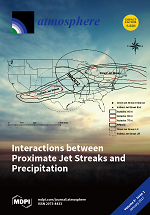Nitrogen trifluoride (NF
3) has the potential to make a growing contribution to the Earth’s radiative budget. In this study, the global mean radiative efficiency of NF
3 is calculated as 0.188 W·m
−2·ppb
−1 by line-by-line method. Global warming potentials
[...] Read more.
Nitrogen trifluoride (NF
3) has the potential to make a growing contribution to the Earth’s radiative budget. In this study, the global mean radiative efficiency of NF
3 is calculated as 0.188 W·m
−2·ppb
−1 by line-by-line method. Global warming potentials of 14,700 for 100 years and global temperature potentials of 16,600 for 100 years are calculated. At the same time, inhomogeneous instantaneous radiative forcing of NF
3 at the top of the atmosphere and its relationship to other atmospheric and surface variables are studied. A total of 42 atmospheric profiles are used. The results show NF
3 instantaneous radiative efficiency range from 0.07 W·m
−2·ppb
−1 to 0.50 W·m
−2·ppb
−1 in clear sky conditions. The mean value is 0.25 W·m
−2·ppb
−1. In clear sky conditions, the correlation coefficient between surface temperature and NF
3 instantaneous radiative forcing is 0.94 and the partial correlation coefficient is −0.88 between integrated water content and NF
3 instantaneous radiative forcing. A regression model is constructed for NF
3 instantaneous radiative forcing based on surface temperature and integrated water content. The average value of the relative error is 6.17% based on LBLRTM (Line-by-Line Radiative Transfer Model) results. The correlation coefficient is 0.985 between cloud radiative forcing and the difference of NF
3 instantaneous radiative forcing between clear sky and all cloudy sky conditions. A regression model is constructed for NF
3 instantaneous radiative forcing in all cloudy sky. The average relative error is 5.9% based on LBLRTM results.
Full article





